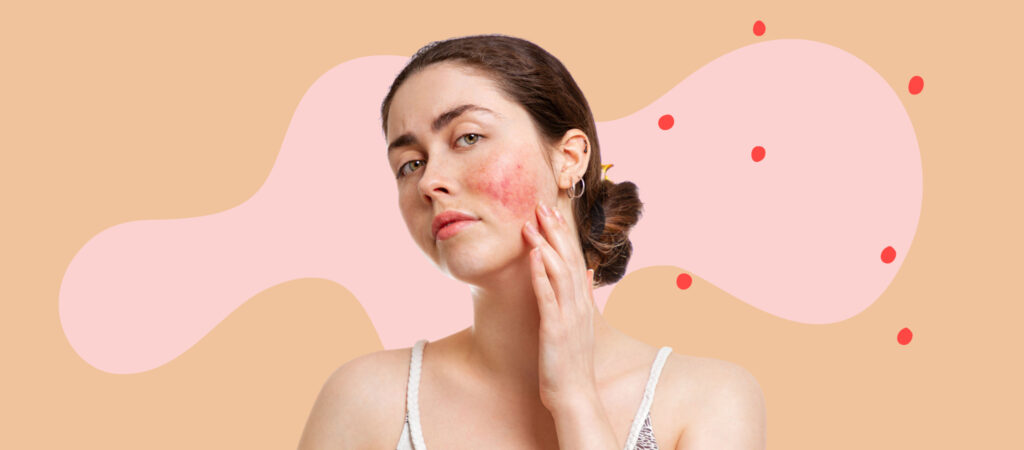8 Ways to Calm A Rosacea Flare-Up

Medically reviewed by Dr. Nancy Shannon, MD, PhD on August 9, 2021
Rosacea flare-ups are pretty much what they sound like: a red, flushed face accompanied by irritation and/or pimple-like lesions. While there are a few steps you can take to prevent rosacea flare-ups in the first place, some are going to be unavoidable.
Anyone who’s suffered from a flare-up of rosacea before knows that the sooner one ends, the better. Everyone’s skin is different, but there are still some measures that can help shorten rosacea flare-ups or reduce their severity. Here are 8 things to try:
- Keep cool.
Warmth can cause the face to become flushed, and flushing can precipitate flare-ups in people with rosacea. One study found that unusually warm skin may contribute to the development of the pustules those with type 2 papulopustular rosacea may experience. The fix here is simple: Avoid especially hot temperatures as much as you can. On hot days, try to stay indoors in the AC or at least in the shade. And on any day, dress in layers so you can shed some if you start to overheat.
Nurx offers prescription treatment for acne, anti aging, melasma, rosacea, and eyelash growth.
- Be shady.
The UV radiation present in sunlight has been connected with rosacea, so be cautious with the sun’s rays. When you’re outdoors, wear a wide-brimmed hat to keep the sun from hitting your face and regularly apply a mineral sunscreen and follow other sun protective measures.
- Moisturize.
Rosacea and skin irritation are connected: flare-ups of rosacea can irritate the skin, and persistent skin irritation can cause a flare-up to occur. While irritation can be caused by a number of different factors, dry skin is one of the most common.
A rosacea flare-up may be soothed by applying a gentle non-comedogenic moisturizer cream that is fragrance- and dye-free. This may not stop the flare-up in its tracks, but it can alleviate some of the irritation that comes along with it. Moisturized skin is better equipped to deal with the aggravation of a rosacea flare-up than dry skin.
- Use a humidifier.
For that reason, increasing the water content of the air can also have an impact. Dry air dries out the skin, so a humidifier ensures that your home’s air doesn’t aggravate your rosacea any further.
- Drink up.
If moisturizers and humidifiers aren’t pulling their weight, that may be an indication that it’s not just your skin that’s dehydrated. Not drinking enough water can eventually lead to persistent dry skin that often takes more than just moisturizing to alleviate, so keep a big water bottle by your side and commit to staying hydrated.
- Avoid stress.
Though stress is not a direct cause of rosacea flare-ups, there are some strong associations to be aware of. Stress and anxiety can lead to skin inflammation, which itself can then produce a rosacea flare-up.
Once a flare-up does begin, remove as many stressors from your environment as possible. As with the other entries on this list, doing so may not cause your flare-up to immediately subside, but you can think of it as a form of damage control: staying stressed throughout a rosacea flare-up can increase inflammation, causing it to last longer and cause more damage as a result.
- Stay away from trigger foods.
There are many different foods that have been shown to trigger flare-ups in people with rosacea. Though your flare-up may not have been caused by one of those foods, you’ll want to avoid eating anything that may cause the flare-up to worsen. The more aggravating factors you avoid during your flare-up, the quicker it will subside and the less damage your skin will be subjected to.
- Use clinical treatments.
Some rosacea flare-ups may seem insurmountable, requiring treatments more serious than those you have already on hand. Available both over-the-counter and as prescriptions, a number of treatments may help to reduce the appearance of rosacea flares. Rosacea treatments are most effective for type 2 (papulopustular rosacea). Type 1 (erythematotelangiectatic) rosacea is usually best managed by avoiding triggers and laser treatments, though sometimes topicals like brimonidine may help.
If you’re wondering which treatments may be best for you, we’re here to help. Get in contact with a member of our medical team today to learn more about how treatments can help you keep the impact of your rosacea flare-ups to an absolute minimum.







